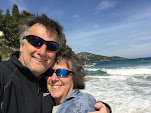Ok
If you are using anything other than zero offset wheels then I think (like me) that you will find the short length of the Serpent axle a bit frustating. He I have pictured it next to a HB 12X axle for comparison.

We really need the longer axle to allow the use of shims to widen the rear track width when we use Jaco or Parma tyres etc. If you use the Serpent part there is not going to be much axle "meat" left in the clamping hub. My solution for now is to use the HB axle shown above. The D rings are just the same. I think the CRC axle would work also. I hope Serpent will sort this issue and change the part. Another 10mm will do the trick! Thankyou!
Watch out! Trust Race Order


Serpent have used the original (and best!) Slapmaster type outer thrust race. The manual does not explain or show that the two thrust washers are different. The inner washer has a larger internal dia of approx 4.25mm and the outer washer is smaller with an ID of 3.97mm. Make sure you put them in the correct order. The axle needs to rotate inside the inner washer without touching or binding on it. This is why it is larger in terms of internal Dia.
Notice that the grove track in each washer should face the thrust ball race. I know this sounds obvious but I have spotted people rebuilding the diff in the pits and missing this point already!.
Do it Like Slapmaster
Now onto another problem. The orange spacer that sits between the hub ball race and the inner thrust race washer could be better designed. The original Slapmaster system used a black plastic spacer that had a locating lip machined onto it. This lip centred the spacer on the hub via the bub ball race without it touching or binding on the axle that was free to rotate inside it. The Serpent part unfortunately has two issues:
1. The orange spacer internal dia is too tight and needs opening out to about 4.25mm. This is easy to fix with a Dremel!


2. There is no locating lip centering the spacer to keep it off the axle.

Left to Right: Standard Orange Serpent : Slapmaster : My Modification
hmmmm: I have two possible solutions here.
First I used my lathe to machine a lip on the spacer as shown right. Ok this is not possible for everyone and to be honest I did not make that good a job of it so....
My second idea was to super glue the orange spacer onto the hub ball race. Now this needs a deft hand, some degreasing and a very light application of cyano. Get this wrong and you will super glue up the ball race (done that! the first one went in the bin).

I have shown below a little trick using paper to ensure the oversized spacer is still centred on the axle as you bring it into contact with the ball race flange (pre-painted with a thin film of glue). Apply your thin film of cyano to the outer flange (only!) of the ball race, then slide the orange guy down the paper'ed shaft to meet it. Apply some pressure while the glue takes.
Now you can remove the paper. The hub ball race and the orange spacer should now be one and the same part. The orange spacer cannot shift to bind on the axle as it is held centre via the positioning of the ball race.
Now follow my old general diff building tips (posted here ages ago!) and you should have a great diff.
Cheers
Mark
















